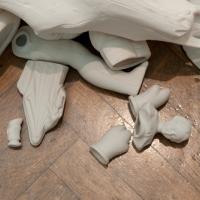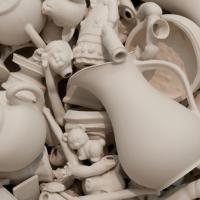Art is just a series of artistic practices; practices done by the artist, the viewer, the curator, the collector. Practices of looking, practices of making, practices of buying, practices of judging and analyzing and practices of interpreting and admiring. Art critic Nicholas Bourriaud theorizes this kind of “artistic practice” in the early 1990’s. In the St. Rosie Needs Arms Series these theories are reaching out for participation and social relationships between viewer and artwork.
Bourriaud brings up the idea of a work speaking to an audience instead of just to a single viewer. The work can bring out social relationships and social situations that may not present themselves otherwise. In this series each piece is talking to the viewers as if they were a whole, instead of bringing out a different reaction in each viewer. The work is commodifying the viewer instead of the reverse.
However, not only does the work commodify the viewer, but also it pleases the viewer. As the observer moves throughout the series it comes to the last sculpture, the conglomerate pile and truly gets to interact. Here the art is not only relational and social but it becomes a gift. The work is admired and glorified and then removed from its comfort and taken away. Here the relational aesthetic truly begins. The viewer always has the need to reach out and touch. The buyer, collector, and art enthusiast has the need to “own” and commodify the work. The nihilist always has the urge to ruin the work and destroy the consumerism around Art (with a capital A). As the viewer reaches this last pile, after seeing the artistic studio practice and the artistic developmental practice the viewer sees and interacts with the artistic relational practice. After a piece is a chosen it is the viewer’s responsibility to finish the sentence and categorize the work. Is it a masterpiece, a piece of shit, a dust collector, a sculpture, or just nothing?
In The Gift: Imagination and the Erotic Life of Property written by Lewis Hyde commodification is written about in the continuous act of gift giving. Hyde mentions that gift giving and owning artwork is similar to Native American’s ancient tradition of the tribe only keeping something by giving it away. Each member would share in the ritual of lighting and smoking the peace pipe and then it would be passed to the next member. In this taking and receiving the gift was conceived and it was only when the giving stopped that the consumption, tradition and the act of taking died as well. The relational aesthetic of continuing in the giving would keep the unity and the commodity of the object or experience going. In the act of the viewer taking a piece of the conglomeration the sculpture at large will begin to leave the gallery and disperse it self throughout a much larger environment keeping not only itself alive but keeping the idea of relational aesthetics, interactive artwork, and viewer participation thriving as well.








